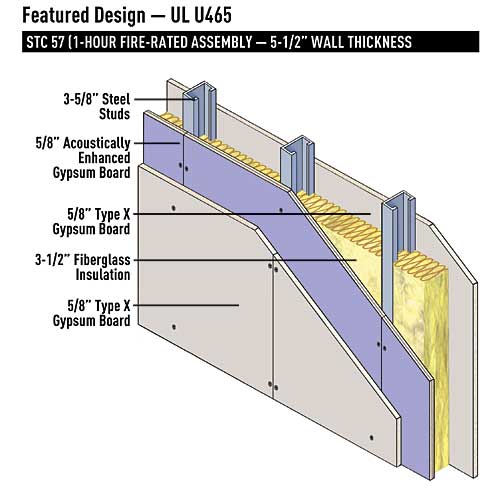Market Trends Drive the Need for Effective Sound Solutions
|
Resilient Furring Channels. Resilient furring channels are designed for sound control by separating the gypsum board from framing members, thereby eliminating a direct pathway for the transmission of noise and vibrations from adjoining areas. In use since the 1960s, resilient furring channels are inserted between one gypsum layer and the wall frame, and can add as many as five STC points. Acting as a shock absorber, the resilient channel softens vibrations coming from either side of the wall. Not all channels are acoustically effective resilient channels. Hat channels, z-channels, and other lightweight metal furring systems may be similar in appearance, but they are too rigid to offer any acoustical benefit.
Resilient furring channels suffer a long history of high failure rates partly because of their potential for faulty installation. It is important to install them correctly as improper installation can void any acoustical benefit. Resilient channels have a wide flange and a narrow flange, with a slotted element in between. On walls, channels should be mounted perpendicular to the framing with the narrow flange along the bottom. A common mistake is to install the furring channel upside down, which severely reduces and can even negate its soundproofing effect.
When installing gypsum board the screws should be connected to the channels between the studs or joists. Screwing them into the wood behind them will "short circuit" the resilient channels because such an inflexible connection defeats their acoustical benefit. Using screws of incorrect lengths will cause the screws to penetrate into the stud framing, to similarly negative effect. Walls should have a slight flex to them when resilient channels have been properly installed. If it is not possible to flex the wall, the channels may have been shorted out by screws fastened into the framing.
Even if the system is installed properly, the solution can very likely be inadvertently compromised by the building occupants. Even inserting a nail into the wall in order to hang a picture, bookshelf or other item can "short-circuit" the acoustical solution if the nail causes the gypsum board to come in contact with a stud.
Staggered or Double-Studded Walls. A double-studded wall is literally two separate rows of studs, top and bottom plates installed and separated from each other. Staggered or double-studded walls will also structurally decouple, or mechanically separate, the two sides of a wall to make it harder for sounds to pass through. Staggered walls are constructed by using a common plate wider than the two rows of offset studs. Studs are set in a zigzag pattern, with each side of the wall attached to a different set of studs. With no common framing of the walls, sound is not directly transmitted from one wall to another. The drawback of staggered or double-studded walls is that this construction tends to increase labor and material costs. Furthermore, the depth of the required partition takes up valuable floor space.
Sound Isolation Clips. Based on the premise that only isolation can effectively reduce low-frequency noise, sound isolation clips are used together with furring channels to fasten the gypsum board to the wall assembly while simultaneously eliminating the hard connection of the wall substrate to actual structural members. In this way, the wall design provides acoustical decoupling. Clips attach easily to wood, steel, or concrete and can add up to 20 STC points to most walls. Here again, relatively higher labor and material costs for wall construction are a disadvantage. In addition, the large number of parts and pieces required for a sound isolation clip system make for a complicated installation with significant potential for error.
|











